The Public Life of Sherlock Holmes: How George Raft Made Bogie a Star
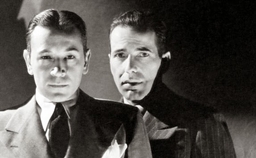 Last week, we talked a lot about Humphrey Bogart as we roamed around The Maltese Falcon. And I had already done a post on Bogie’s only horror-sci fi film, The Return of Doctor X. Today, I’m going to talk about one of my favorite aspects of Bogart’s career. In the annals of Hollywood, never has one actor so torpedoed his own career, while making another actor a star at the same time. Let’s take a look, shall we?
Last week, we talked a lot about Humphrey Bogart as we roamed around The Maltese Falcon. And I had already done a post on Bogie’s only horror-sci fi film, The Return of Doctor X. Today, I’m going to talk about one of my favorite aspects of Bogart’s career. In the annals of Hollywood, never has one actor so torpedoed his own career, while making another actor a star at the same time. Let’s take a look, shall we?
George Raft grew up in Hell’s Kitchen, New York, where he was a childhood friend of Owney Madden, who would become a powerful mobster in the days of Prohibition. Raft toyed with being a boxer and then taught himself to dance, hitting it big in Vaudeville in the early twenties. At the same time, he hung out with professional gangsters, gaining access to them through his friendship with Downey. He studied how they walked and talked, and mastered the ability to imitate them.
After appearing in a few films as a dancer, Raft broke through in 1932. Long before Rod Steiger and Al Pacino played Capone roles, Paul Muni made a classic gangster film: Scarface – Shame of a Nation. Raft had a part as Rinaldo, a coin-flipping gunman. Emulating the men he knew, he received strong reviews for his performance.
In fact, he became a star. He had the lead in a 1935 version of Dashiell Hammett’s The Glass Key, though it is Alan Ladd’s portrayal in 1942 that is remembered today. Several elements of The Glass Key can be found in the Coen Brothers’ Miller’s Crossing, one of the finest gangster films of the past forty years.
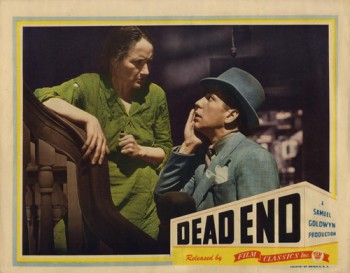 In 1937, Raft turned down the role of Baby Face Martin in Dead End. He felt that Martin wasn’t sympathetic enough, and he didn’t like the way Martin’s mother slapped him in the movie. Dead End had been a very successful stage play and MGM was making a big budget adaptation. It would have been a fine role for Raft. Instead, Bogart was cast as Martin and got very good reviews. The film was directed by William Wyler, who would tap Bogart late in his career for the lead role in The Desperate Hours. So, Raft rejected a role and Humphrey Bogart ended up with it. A pattern is on the cusp of developing.
In 1937, Raft turned down the role of Baby Face Martin in Dead End. He felt that Martin wasn’t sympathetic enough, and he didn’t like the way Martin’s mother slapped him in the movie. Dead End had been a very successful stage play and MGM was making a big budget adaptation. It would have been a fine role for Raft. Instead, Bogart was cast as Martin and got very good reviews. The film was directed by William Wyler, who would tap Bogart late in his career for the lead role in The Desperate Hours. So, Raft rejected a role and Humphrey Bogart ended up with it. A pattern is on the cusp of developing.
Raft signed with Warner Brothers in 1939 as part of its “Murder’s Row.” Paul Muni, James Cagney and Edward G. Robinson were already at Warners and gave the studio the strongest lineup of tough guy leading men in Hollywood. Muni, whose days at Warners were winding down, was top dog but Raft had every opportunity to supplant Cagney and Robinson to become number two. Meanwhile, a guy named Bogart played supporting roles in which he was usually gunned down by the star (maybe he could have headed up Warner’s “Murdered Row”).
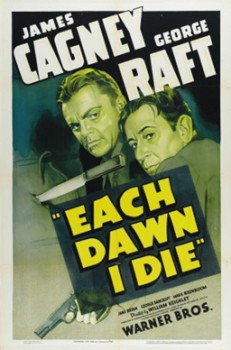 Word is that as soon as Raft signed with Warners, he bumped Bogart out of the “Hood Stacey” role in Each Dawn I Die, with James Cagney. Cagney had already knocked off Bogart in the gangster flicks Angels With Dirty Faces and The Roaring Twenties, all of which were well received (a third venture, The Oklahoma Kid, saw Cagney’s brother killing off Bogart). Each Dawn I Die holds up well today but might have been even better with Bogart instead of Raft: then again, maybe not.
Word is that as soon as Raft signed with Warners, he bumped Bogart out of the “Hood Stacey” role in Each Dawn I Die, with James Cagney. Cagney had already knocked off Bogart in the gangster flicks Angels With Dirty Faces and The Roaring Twenties, all of which were well received (a third venture, The Oklahoma Kid, saw Cagney’s brother killing off Bogart). Each Dawn I Die holds up well today but might have been even better with Bogart instead of Raft: then again, maybe not.
The careers of Bogart and Raft would be inextricably linked for the next three years and by 1943, Bogart was the biggest star in Hollywood and Raft was reduced to making a movie that attempted to copy the success of a Bogart film.
In 1939, Raft and Bogart made a forgettable film called Invisible Stripes. Released from prison, Raft goes on the straight and narrow while Bogart falls back into his bad habits. Circumstances force Raft to resume a life of crime but he manages to quit the gang and both Raft and Bogart are gunned down by other mobsters near the film’s end. It was one of seven (yes, seven) films Bogart made that year.
He was shot to death in four of them (King of the Underworld, The Oklahoma Kid, The Roaring Twenties and Invisible Stripes); sentenced to be electrocuted in another (You Can’t Get Away Wirth Murder) and shot down after having been electrocuted and raised from the dead in another (The Return of Doctor X). He wasn’t exactly getting star quality parts.
Ironically enough, though he had only a minor part in Dark Victory, Bogie received good reviews for the one role when he was allowed to live. Bette Davis, star of Dark Victory, made five films with Bogart (I don’t really count cameos in Thank Your Lucky Stars) but reportedly disliked him. I don’t know if that’s actually true. Bogie was cast opposite Davis in her next film, a Civil War flick entitled The Old Maid. But after four days of filming, he was determined to be so unsuited to a romantic lead that he was replaced by George Brent.
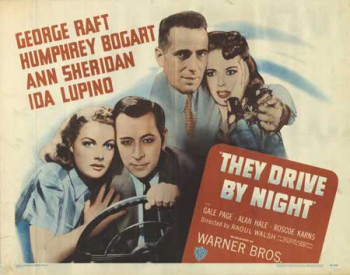 While Raft had star billing in Invisible Stripes, the number two male spot went to William Holden, with Bogart one slot below him. Bogart was annoyed, as this was only Holden’s second credited role, while it was Bogart’s thirty-second. It’s possible that this bad feeling in 1939 was at the root of their dislike for each other during the filming of Sabrina some fifteen years later.
While Raft had star billing in Invisible Stripes, the number two male spot went to William Holden, with Bogart one slot below him. Bogart was annoyed, as this was only Holden’s second credited role, while it was Bogart’s thirty-second. It’s possible that this bad feeling in 1939 was at the root of their dislike for each other during the filming of Sabrina some fifteen years later.
In 1940, Raft would star in They Drive By Night, with Bogart playing his brother in this trucker film. Third-billed Ida Lupino turned out to be the star of the movie, breaking down in a memorable courtroom scene late in the film. Bogart was billed number four, with Ann Sheridan holding down the second spot. That same year, Raft turned down the lead in a gangster comedy called It All Came True and Bogart took the part. It wasn’t a very memorable film: just one of the seventeen movies he made from 1938 through 1940! Bogart was again billed below Ann Sheridan (she was the star; he was third bill).
Warners had given Raft a big buildup and he seemed to believe his own press. In 1938, he had said in a letter to Jack Warner: “I was afraid the studio would put me in parts that Humphrey Bogart should play and you told me that I would never have to play a Humphrey Bogart part.” That attitude led Raft to really screw himself over three years later.
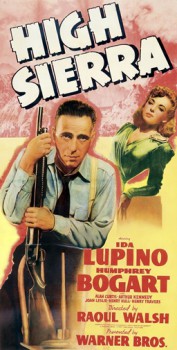 Humphrey Bogart had worked in thirty-seven films in the previous eleven years, but it was in 1941 that Raft inadvertently made him a star. Back in 1938, a young John Huston had co-written the script to The Amazing Dr. Clitterhouse, starring Edward G. Robinson and Claire Trevor. Bogie had third billing as gangster Rocks Valentine (poisoned by Robinson in this appearance). In 1941, Huston worked with author W.R. Burnett on the screenplay for the latter’s novel, High Sierra. Raft turned down the movie, saying he didn’t want to play a gangster. Also, he didn’t like the fact that Roy Earle died at the end of the film.
Humphrey Bogart had worked in thirty-seven films in the previous eleven years, but it was in 1941 that Raft inadvertently made him a star. Back in 1938, a young John Huston had co-written the script to The Amazing Dr. Clitterhouse, starring Edward G. Robinson and Claire Trevor. Bogie had third billing as gangster Rocks Valentine (poisoned by Robinson in this appearance). In 1941, Huston worked with author W.R. Burnett on the screenplay for the latter’s novel, High Sierra. Raft turned down the movie, saying he didn’t want to play a gangster. Also, he didn’t like the fact that Roy Earle died at the end of the film.
With that decision, Raft’s short stay at Warners began its decline and Bogart was starting to climb out of B movie purgatory.
After Raft declined the part, Warners turned to Paul Muni. Muni had not made a film at Warners since 1937 and was fighting with the studio. You know, Jack Warner seemed to be constantly battling his stars. Muni followed Raft and turned down the role. As it turns out, he had already made his last movie at Warner Brothers.
While Raft and Muni definitely refused the part, rumor has it that Cagney and Robinson also said no. When Bogart heard that Raft and Muni were out, he telegraphed Hal Wallis: “Dear Hal: You once told me to let you know when I found a part I wanted.” Bogie wanted to be Roy Earle.
With four of Warner’s top stars crossed off, Bogart was cast opposite Ida Lupino, who got top billing. There is speculation that Bogart was originally to receive the top spot but his recent brush with the House Un-American Activities Committee, as well as his status as a B lead, resulted in Lupino getting top billing instead. While Jack Warner certainly wouldn’t hesitate at such a move, Lupino was a hotter commodity after her turn in They Drive By Night and probably had more potential to move the film than Bogart at this stage in his career.
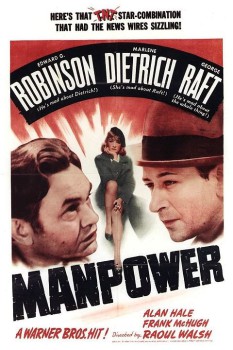 Regardless, Bogart received rave reviews as the criminal with a tender side. Critics and fans loved him and he enjoyed his biggest success since The Petrified Forest. Raft had blown a chance to star in a hit film. Something he would certainly regret as his career regressed.
Regardless, Bogart received rave reviews as the criminal with a tender side. Critics and fans loved him and he enjoyed his biggest success since The Petrified Forest. Raft had blown a chance to star in a hit film. Something he would certainly regret as his career regressed.
Next up for Lupino was Out of the Fog, based on the Irwin Shaw play, Gentle People. Bogart wanted that one but Lupino, who hadn’t enjoyed working with him in Sierra (Bogie had no idea) told Warners that she didn’t want him in the film. So, John Garfield got the part.
It’s Elementary – Lupino had the female lead in Basil Rathbone’s second film as the great detective, The Adventures of Sherlock Holmes.
Raft made only one movie in 1941, Manpower, costarring with Bogart and Marlene Dietrich. Raft wasn’t happy with Bogart and had him removed from the film just after shooting started. Bogart was upset but was not reinstated to the film. Edward G. Robinson replaced Bogie and the mild-mannered star ended up in a fight with Raft. The movie was mediocre. Raft was 0 for 2 that year.
Edward G. Robinson helped create the Hollywood gangster as Rico in 1931’s Little Caesar. He played his last mobster, (Johnny) Rocco, in 1948’s Key Largo. In between, he had starred in Bullets or Ballots, Kid Galahad, The Amazing Dr. Clitterhouse and Brother Orchid, killing Bogart in all of them. His success waned in the fifties but he had a final hurrah opposite Steve McQueen in 1965’s The Cincinnati Kid.
Bogart, upset at losing Manpower, was even more upset when he was sent the script for Bad Men Of Missouri. He was to star as the eldest of the three Younger brothers, with Wayne Morris (who was actually billed above Bogart in Men Are Such Fools and The Return of Doctor X but featured below Bogie in China Clipper and Kid Galahad) and Arthur Kennedy (fresh off High Sierra, his second film). The female lead was played by future Oscar winner and Mrs. Ronald Reagan, Jane Wyman. Legend is that Bogart wrote “Are you kidding – this is certainly rubbing it in – since Lupino and Raft are casting pictures, maybe I can.” on the script and sent it back to Jack Warner, who quickly suspended him. Dennis Morgan replaced Bogart.
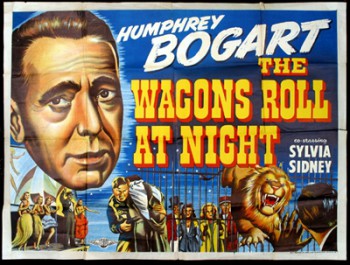 Having already passed on two good roles that Bogart benefited from, Raft did make one good decision in 1941: he refused to make The Wagons Roll at Night, which starred Bogart instead. It was a circus movie, and it was as bad as High Sierra was good. The second female lead was Joan Leslie, who had played Velma, Roy Earle’s unrequited love in High Sierra. She played second banana to Sylvia Sidney, star of Dead End a few years before. Eddie Albert, who went on to fame in television’s Green Acres, featured prominently. Warners didn’t know what to do with Bogart, as this movie was a significant step down from High Sierra. It was promoted “For the millions who cheered They Drive By Night!” That was a bit of a stretch.
Having already passed on two good roles that Bogart benefited from, Raft did make one good decision in 1941: he refused to make The Wagons Roll at Night, which starred Bogart instead. It was a circus movie, and it was as bad as High Sierra was good. The second female lead was Joan Leslie, who had played Velma, Roy Earle’s unrequited love in High Sierra. She played second banana to Sylvia Sidney, star of Dead End a few years before. Eddie Albert, who went on to fame in television’s Green Acres, featured prominently. Warners didn’t know what to do with Bogart, as this movie was a significant step down from High Sierra. It was promoted “For the millions who cheered They Drive By Night!” That was a bit of a stretch.
Later in 1941, Raft made a mistake that effectively ended his run as a top dog at Warners and launched Bogart. John Huston had worked on several successful screenplays for Warners, so they “threw him a bone” and let him direct a movie. He chose to do a film of Dashiell Hammet’s private eye novel, The Maltese Falcon. It wasn’t the first attempt, but it would certainly be the best.
Raft was tagged for the lead. He wrote a letter to Jack Warner, reminding him that Warner had promised him that Raft would only have to play in important films, which this would not be. He also didn’t want to entrust his career to a rookie director. Finally, it was a remake, which he didn’t have to make, according to his contract. In fact, this clause was how he had gotten out of doing The Wagons Roll at Night.
On the surface, Raft’s reasoning was sound. There had been two prior versions of the movie. In 1931, Ricardo Cortez starred in a sort of “Thin Man” version of the tale, heavier on the romance. It didn’t work. In 1936, the story was changed around drastically and Bette Davis starred in the “funny” Satan Met a Lady. Strike two. Raft had every reason to believe that the next remake would be a flop as well: So much for his instincts.
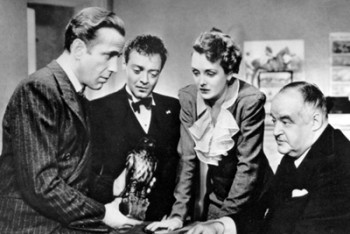 But John Huston didn’t want to rewrite the novel. He used much of the dialogue directly from the book and he didn’t turn it into a comedy. Seventy-five years later, The Maltese Falcon is still regarded as the finest detective film ever made. Bogart formed a lifelong friendship with John Huston, which resulted in some of his greatest movies, and Peter Lorre and Sidney Greenstreet became a casting pair, sometimes with Bogart, sometimes on their own.
But John Huston didn’t want to rewrite the novel. He used much of the dialogue directly from the book and he didn’t turn it into a comedy. Seventy-five years later, The Maltese Falcon is still regarded as the finest detective film ever made. Bogart formed a lifelong friendship with John Huston, which resulted in some of his greatest movies, and Peter Lorre and Sidney Greenstreet became a casting pair, sometimes with Bogart, sometimes on their own.
Raft had missed a golden opportunity to make up for his mistake in passing on High Sierra. Put Raft in those two John Huston projects and it’s quite possible Bogart would never have escaped his second-tier status at Warners, while Raft would be considered a continuing star. It’s hard to imagine Bogart cast in Casablanca without High Sierra and The Maltese Falcon on his resume.
Bogart’s next film was All Through The Night. Raft had turned this one down as well, reason unknown. A good guess is that he still refused to play gangsters, though this one is a good guy who doesn’t get gunned down. Hollywood hadn’t quite mastered the art of the war movie by the end of 1941 and the quick response had been to convert the well-established gangster genre into war films.
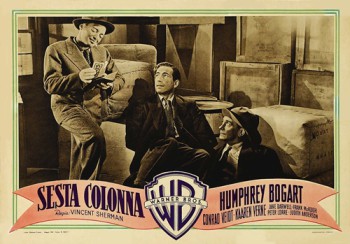 All Through the Night is a gangster comedy in which Bogart plays Gloves Donohue, a mobster who thwarts a Nazi plot in New York City. Conrad Veidt played the head villain. Veidt would be much better known the following year as Major Strasser in Casablanca. It is thought that when Rick Blaine (Bogart) tells Strasser: “Well, there are certain parts of New York, Major, that I wouldn’t advise you to try and invade,” he’s referencing All Through the Night. This is actually one of my favorite Bogart films. It didn’t do much for his career, but nor did it hurt it.
All Through the Night is a gangster comedy in which Bogart plays Gloves Donohue, a mobster who thwarts a Nazi plot in New York City. Conrad Veidt played the head villain. Veidt would be much better known the following year as Major Strasser in Casablanca. It is thought that when Rick Blaine (Bogart) tells Strasser: “Well, there are certain parts of New York, Major, that I wouldn’t advise you to try and invade,” he’s referencing All Through the Night. This is actually one of my favorite Bogart films. It didn’t do much for his career, but nor did it hurt it.
Bogart was reunited on the set with his Maltese Falcon buddy Peter Lorre, now cast as a despicable piano player (Lorre is despicable, not the piano). In addition to the two movies mentioned, Bogart and Lorre appeared together in Casablanca, Passage to Marseille and Beat the Devil. Lorre, once an outstanding actor, was now bloated (a result of alcohol and prescription meds) and in Beat the Devil he barely resembles the dapper Joel Cairo of Falcon fame.
The female lead was Kaaren Verne, who divorced her husband, married Lorre, put her career on hold, got divorced five years later only to find that her time had passed and then faded into movie obscurity. There are some great supporting actors in this movie, including Jackie Gleason (The Honeymooners), William Demarest (Uncle Charlie in My Three Sons), Phil Silvers (Sgt. Bilko) and frequent Bogie costars, Barton MacLane and Frank McHugh.
As indicated previously, actors appeared in several movies a year during the days of the studio system. B actors appeared regularly in studio projects. Barton MacLane, best remembered today as General Peterson in I Dream of Jeannie, was in over 170 film and television productions from 1926 through 1969 (the year of his death). In addition to All Through the Night, he appeared with Bogart in Bullets or Ballots, San Quentin, High Sierra, The Maltese Falcon and Treasure of the Sierra Madre. He was also in Manpower, which Raft bumped Bogart from.
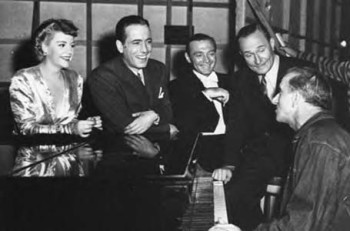
Frank McHugh appeared in over eighty movies in the nineteen thirties alone, often providing excellent comic relief. He is hilarious in All Through the Night, his fourth film with Bogie (Bullets or Ballots, The Roaring Twenties and Virginia City), and he’s another near-costar from Manpower (everybody but Bogart seems to have been in that film). McHugh made many television guest spots in the fifties and sixties but is largely unknown today.
Bogart’s very next film was The Big Shot. Yep, you guessed it: Raft turned this down, saying he didn’t want to do gangster films. You have to credit him on this one. The Big Shot didn’t have any other stars and wasn’t much of a movie, with the undistinguished Irene Manning the female lead. Directed by Lewis Seiler, Warners had given him Bogart for several forgettable movies: Crime School (1938), King of the Underworld (1939), and You Can’t Get Away With Murder (1940). Fortunately, this was to be their last pairing, though you can’t blame Seiler for the weak scripts in every one of their movies together.
Meanwhile, Raft made only one movie in 1942: a musical with Pat O’Brien called Broadway. Having turned down quite a few parts, he finally starred as himself in a look back at his Broadway days as a singer and party boy. I don’t believe it’s even shown on late night cable television.
Well, we’re up to Casablanca. It’s not clear whether Raft wanted to play Rick Blaine or not. A memo does exist, in which Jack Warner asks studio exec Hal Wallis what he thought about using Raft for the part. Wallis replied that it was being written for Bogart, and that was the end of that idea. Casablanca made Humphrey Bogart a legend (even though Paul Lukas won the Oscar for his performance for Watch on the Rhine). Only three years earlier, Bogart had been toiling in forgettable flicks and getting fourth billings while Raft was a star.
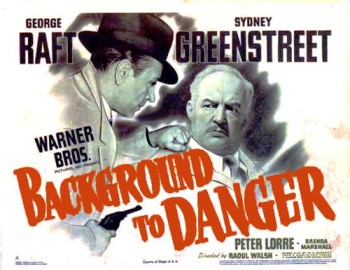 In 1943, Raft made his own version of Casablanca, called Background to Danger. American Joe Barton fought the Nazis in World War II Turkey and the movie featured Sydney Greenstreet and Peter Lorre. It wasn’t a hit and Raft’s career was pretty much done, though he did manage to blow one last chance later that year.
In 1943, Raft made his own version of Casablanca, called Background to Danger. American Joe Barton fought the Nazis in World War II Turkey and the movie featured Sydney Greenstreet and Peter Lorre. It wasn’t a hit and Raft’s career was pretty much done, though he did manage to blow one last chance later that year.
Billy Wilder approached Raft for the role of Walter Neff in Double Indemnity, based on James M. Cain’s novel of the same name. Raft said he would take the part, but only if it turned out that Neff was an FBI agent trying to nail Barbara Stanwyck as the murderer. If you’ve seen the film, which is justly regarded as a noir classic, you know that this is yet another shining example of Raft having no clue about good roles and scripts.
Fred MacMurray, best remembered today as dad Steve Douglas on My Three Sons, was superb in the role as written by Wilder and Raymond Chandler, whose novel The Big Sleep became another of Bogart’s successes. MacMurray later played the duplicitous Lt. Tom Keefer in Bogart’s The Caine Mutiny.
Raft had a nice part in Marilyn Monroe’s Some Like It Hot, with a stellar cast including Monroe, Jack Lemmon and Tony Curtis. The George Raft Story was made in 1961 and a character in Francis Ford Coppola’s Cotton Club was based on Raft (Richard Gere played that part). Ironically, his last part was in 1980’s The Man With Bogart’s Face. A private eye has surgery so that he looks like Bogart. Raft has twelfth billing in a film which feature’s Bogart’s name in the title. How about that?
It’s believed that Raft was largely illiterate and it has been asserted that he turned down some scripts because he couldn’t fully comprehend the characters. Also, because he knew so many gangsters and was a part of their circle, he didn’t like playing them on screen. And, he didn’t like to work with inexperienced directors. This combination torpedoed a successful career.
In 1939, Raft was making $5,500 per week, which was more than fellow Warners’ stars Errol Flynn and Pat O’Brien (James Cagney got $12,500, Edward G. Robinson $8,500). Humphrey Bogart was pulling down $1,250 per week, less than John Garfield, George Brent and Donald Crisp (who made over 130 movies, including four with Bogart). Bogart had made twenty-five films at the time, with only The Petrified Forest being somewhat memorable.
In a three-year period, George Raft completely sabotaged himself and helped Humphrey Bogart launch a career that has resulted in him being regarded as the greatest actor of all time. He never understood that playing a bad guy could be a good part. Maybe Raft should just have kept dancing in films.
You can read Bob Byrne’s ‘The Public Life of Sherlock Holmes’ column here at Black Gate every Monday morning.
He founded www.SolarPons.com, the only website dedicated to the ‘Sherlock Holmes of Praed Street’ and blogs about Holmes and other mystery matters at Almost Holmes.
His “The Adventure of the Parson’s Son” is included in the largest collection of new Sherlock Holmes stories ever published. Suprisingly, they even let him back in for Volume IV!
Nice slice of exhaustive film history. Have always loved “They Drive by Night.” Let’s not forget Edgar G. Robinson’s other final hurrah in “Soylent Green.”
Thanks Jeffrey. I just find the overlap between the two, and the magnitude of Raft’s mistakes, a fascinating story.
‘They Drive By Night’ was the first time I saw Ida Lupino. I thought she was awesome! I was in my early twenties and I was so impressed, I found her address and sent a letter to her in the nursing home she was living in. I never heard back, but she made a lasting impression on me.
It’s not the best gangster film, but ‘Bullets or Ballots’ is one of my favorites in the genre. Robinson and Bogie were great.
[…] you’re a Bogart fan, you really should head on over to Black Gate and see the details: I couldn’t make this stuff […]